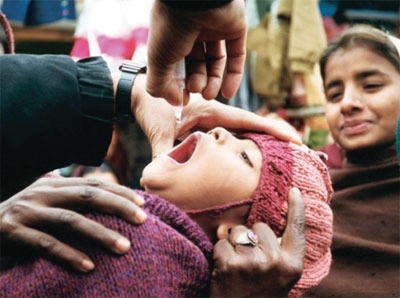Despite a nearly 10-fold surge in the incidence of polio in India over the past 2 years, researchers are optimistic it can be eliminated in that country by 2008.
In 2006, India had 597 reported polio cases (as of Dec. 18), up from 66 the year before, which was the lowest recorded rate ever, says Sona Bari, spokesperson for the Polio Eradication Initiative at the World Health Organization.
The increase in polio cases may be due to a decrease in the vaccine coverage. In 2005, 93% households were vaccinated in India's campaign against polio, but in January 2006, the coverage was 89%. T. Jacob John, a member of India Expert Advisory Group, a group of polio eradication experts, says “virtually 100% coverage is necessary — not simply with 3 but some 10 or even more [doses] in places with very high force of wild virus transmission.”
India deploys 2 types of vaccines in its battle against polio: the standard trivalent vaccine, which works against all 3 strains of poliovirus; and, since 2005, a monovalent vaccine for specific protection against the most prevalent type 1 poliovirus. However, despite the use of monovalent vaccine since 2005, the number of cases has not decreased. Of the 597 reported cases last year, 18 were type 3 and the rest were type 1.
Nicholas Grassly, a researcher at the Imperial College, London, UK, says “It appears that this unfortunate increase [in polio cases] resulted from an increase in mid-2005 of the number of houses ‚missed' by the pulse polio program in western Uttar Pradesh.”
Missed houses include those where the children were absent, vaccination was refused or it was reported that the child had received vaccine despite evidence to the contrary.
India's 2006 campaign emphasized logistics, according to Bari, including meticulous plans, thorough training of vaccinators, availability of vaccine and funds, deployment of necessary supervisory personnel and a full information campaign throughout the community.
Despite the surge in cases, the strategy seems to be succeeding. “The [pulse polio] program has seen significant improvements over [2005], and the number of missed houses is at an all time low,” says Grassly.
He adds that the major challenge now is to ensure that children receive the new monovalent vaccine early enough in their life, which requires frequent vaccination rounds, and that missed children don't remain missed. “If this can be achieved, then we should not see polio in India after 2008,” he comments.
While vaccination is vital, there are also systemic factors potentially feeding the prevalence rate of the virus. Grassly and coworkers recently studied 96 421 polio-affected Indian children, which suggests that high population density and poor sanitation are key factors for the transmission of poliovirus in Uttar Pradesh and Bihar, the states that have accounted for most of the polio cases in India over the last few years (Science 2006;314:1150-3).
These same factors facilitate the transmission of other infectious diseases that interfere with the efficacy of the oral polio vaccine, says Grassly. “New strategies based on the use of monovalent vaccine, which is more efficacious, have the potential to now finish the job and eradicate polio from India.” — Dr. Sanjit Bagchi, West Bengal, India

Figure. The incidence of polio is on the rise again in India. Photo by: Courtesy of Ellyn Ogden/US Agency for International Development


